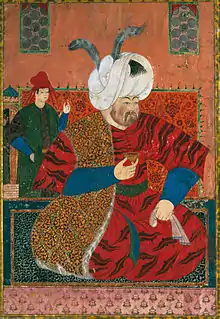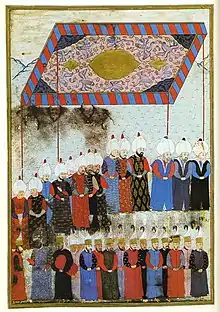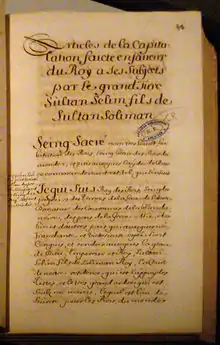Selim II
Selim II (Ottoman Turkish: سليم ثانى Selīm-i sānī, Turkish: II.Selim; 30 May 1524 – 15 December 1574), also known as Sarı Selim ("Selim the Blond") or Sarhoş Selim ("Selim the Drunk"),[3] was the Sultan of the Ottoman Empire from 1566 until his death in 1574. He was a son of Suleiman the Magnificent and his wife Hurrem Sultan. Selim had been an unlikely candidate for the throne until his brother Mehmed died of smallpox, his half-brother Mustafa was strangled to death by the order of his father, his brother Cihangir died of grief at the news of this latter execution, and his brother Bayezid was killed on the order of his father after a rebellion against Selim.
| Selim II سليم ثانى | |||||
|---|---|---|---|---|---|
| Kayser-i Rûm Custodian of the Two Holy Mosques Ottoman Caliph Amir al-Mu'minin | |||||
 | |||||
| 11th Sultan of the Ottoman Empire (Padishah) | |||||
| Reign | 7 September 1566 – 15 December 1574 | ||||
| Sword girding | 8 September 1566 | ||||
| Predecessor | Suleiman I | ||||
| Successor | Murad III | ||||
| Born | 30 May 1524[1] Topkapı Palace, Istanbul, Ottoman Empire | ||||
| Died | 15 December 1574 (aged 50) Topkapı Palace, Istanbul, Ottoman Empire | ||||
| Burial | Hagia Sophia, Istanbul | ||||
| Spouse | Nurbanu Sultan | ||||
| Issue | see below | ||||
| |||||
| Dynasty | Ottoman | ||||
| Father | Suleiman I | ||||
| Mother | Hurrem Sultan | ||||
| Religion | Sunni Islam | ||||
| Tughra |  | ||||
Selim died on 15 December 1574 and was buried in Hagia Sophia.
Early life
Selim was born in Constantinople (Istanbul), on 30 May 1524,[1] during the reign of his father Suleiman the Magnificent. His mother was Hurrem Sultan, a slave and concubine who was born an Orthodox priest's daughter in contemporary Ukraine,[4] and later was freed and became Suleiman's legal wife.[5]
In 1545, at Konya, Selim married Nurbanu Sultan, whose background is disputed. It is said that she was originally named Cecelia Venier Baffo, or Rachel, or Kale Katenou. She was the mother of Murad III, Selim's successor.
Hubbi Hatun, a famous poet of the sixteenth century, was a lady-in-waiting to him.
Reign

Selim II gained the throne after palace intrigue and fraternal dispute, succeeding as sultan on the 7th of September 1566. Selim's Grand Vizier, Mehmed Sokollu and wife, Nurbanu Sultan, a native of what is now Bosnia and Herzegovina, controlled much of state affairs, and two years after Selim's accession succeeded in concluding at Constantinople a treaty (17 February 1568) with the Habsburg Holy Roman Emperor, Maximilian II, whereby the Emperor agreed to pay an annual "present" of 30,000 ducats and granted the Ottomans authority in Moldavia and Walachia. Gazanfer Agha (d. 1602), a friend to Selim and to the writer Mustafa Ali, was castrated so he could serve in Selim's harem. (Gazanfer's younger brother Cafer was also castrated, but did not survive.)[6]
A plan had been prepared in Constantinople for uniting the Volga and Don by a canal in order to counter Russian expansion toward the Ottomans' northern frontier. In the summer of 1569 a large force of Janissaries and cavalry were sent to lay siege to Astrakhan and begin the canal works, while an Ottoman fleet besieged Azov. However, a sortie from the Astrakhan garrison drove back the besiegers. A Russian relief army of 15,000 attacked and scattered the workmen and the Tatar force sent for their protection. The Ottoman fleet was then destroyed by a storm. Early in 1570 the ambassadors of Ivan IV of Russia concluded at Istanbul a treaty that restored friendly relations between the Sultan and the Tsar.
Expeditions in the Hejaz and Yemen were more successful, but the conquest of Cyprus in 1571,[7] led to the naval defeat against Spain and Italian states in the Battle of Lepanto in the same year.
At the historic Battle of Naupaktos or Battle of Lepanto, on 7 October 1571, the Holy League defeated the Ottoman navy decisively; the Holy League sank or destroyed 50 Ottoman ships and captured 117 galleys and 20 galliots, 30,000 Turks were lost in battle, 10,000 Turks were taken prisoners, and many thousands of Christian slaves were rescued. The Holy League lost about 7,500 men.
The Empire's shattered fleets were soon restored (in just six months, it consisted of about 150 galleys and eight galleasses), and the Ottomans maintained control of the eastern Mediterranean (1573). In August 1574, months before Selim's death, the Ottomans regained control of Tunis from Spain, which had captured it in 1572.
Selim is known for restoring to Mahidevran Sultan her status and her wealth. He also built the tomb of his eldest brother, Şehzade Mustafa, who was executed in 1553.
In the famine of 1573, due to severe cold the farmers of that time did not provide good for the people. Selim gave people food and vegetables in the food kitchen. [8] In April 1574, a fire broke in the printing house of Topkapi Palace and burned many rooms including the cooks and maids were burned and the kitchen was also burned. [8] A few days later the captain, the Janissary, Istanbul lord and Mimar Sinan determined the location and size of the new kitchens to come to the fire. Mimar Sinan Ağa cleaned the fireplace of the "building of the official building (design)" of Üslüb-ı ahar. The construction of the new Matbalı-ı Amir, which is broader and longer than the previous one, was taken from Divan-ı Ali Square. [8]
Character

He is introduced as a generous monarch who is fond of pleasure and entertainment in the sources of the period, who is fond of drink councils, enjoys the presence of scholars and poets around him, as well as musicians, wrestlers, and connoisseurs, who do not want to break the hearts of anyone. However, it is stated that he did not appear much in public, that his father often went to Friday and he went public and he neglected this and spent time in the palace.[1]
Family
Selim's first and only wife, Nurbanu Sultan, was a Venetian who was the mother of his successor Murad III and three of his daughters. As a Haseki Sultan she received 1,000 aspers a day, while lower-ranking concubines who were the mothers of princes received 40 aspers a day. Selim bestowed upon Nurbanu 110,000 ducats as a dowry, surpassing the 100,000 ducats that his father bestowed upon his mother Hürrem Sultan. According to a privy purse register cited by Leslie Pierce, Selim had four other women, and each of them was mother of a prince.
- Consorts
- Nurbanu Haseki Sultan, mother and Valide of Murad III;
- Mother of Şehzade Mehmed;[9]
- Mother of Şehzade Mustafa;[9]
- Mother of Şehzade Suleiman;[9]
- Mother of Şehzade Abdullah.[9]
- Sons
Selim had seven sons:
- Murad III (4 July 1546, Manisa Palace, Manisa – 15 January 1595, Topkapı Palace, Istanbul, buried in Murad III Mausoleum, Hagia Sophia), son of Nurbanu Sultan;
- Şehzade Mehmed (died 1572, Topkapı Palace, Istanbul, buried in Hürrem Sultan Mausoleum, Süleymaniye Mosque);
- Şehzade Abdullah (murdered 22 December 1574, Topkapı Palace, Istanbul, buried in Selim II Mausoleum, Hagia Sophia Mosque);
- Şehzade Cihangir (murdered 22 December 1574, Topkapı Palace, Istanbul, buried in Selim II Mausoleum, Hagia Sophia Mosque)
- Şehzade Mustafa (murdered 22 December 1574, Topkapı Palace, Istanbul, buried in Selim II Mausoleum, Hagia Sophia Mosque);
- Şehzade Osman (murdered 22 December 1574, Topkapı Palace, Istanbul, buried in Selim II Mausoleum, Hagia Sophia Mosque);
- Şehzade Suleiman (murdered 22 December 1574, Topkapı Palace, Istanbul, buires in Selim II Mausoleum, Hagia Sophia Mosque).
- Daughters
Selim had at least four daughters:
- Ismihan Sultan (1545, Manisa Palace, Manisa – 8 August 1585, Istanbul, buried in Selim II Mausoleum, Hagia Sophia Mosque), daughter with Nurbanu, married firstly in 1562 to Sokollu Mehmed Pasha, married secondly in 1584 to Kalaylıkoz Ali Pasha;[10]
- Gevherhan Sultan (1544, Manisa Palace, Manisa - fl. 1622, Istanbul, buried in Selim II Mausoleum, Hagia Sophia Mosque), daughter with Nurbanu, married firstly in 1562 to Piyale Pasha, married secondly in 1579 to Cerrah Mehmed Pasha;[10]
- Şah Sultan (1544, Manisa Palace, Manisa – 3 November 1577, Istanbul, buried in Zal Mahmud Paşa Mausoleum, Eyüp), daughter of Nurbanu, married firstly in 1562 to Çakırcıbaşı Hasan Pasha, married secondly in 1574 to Zal Mahmud Pasha;[10]
- Fatma Sultan (1559, Konya Palace, Konya – October 1580, Istanbul, buried in Selim II Mausoleum, Hagia Sophia Mosque), married in 1574 to Kanijeli Siyavuş Pasha;[10]
References
- "SELİM II (1574): Osmanlı padişahı (1566-1574)". İslam Ansiklopedisi. Retrieved 11 January 2020.
- Garo Kürkman, (1996), Ottoman Silver Marks, p.41
- Somel, Selçuk Akşin (2003). Historical Dictionary of the Ottoman Empire. Lanham, Maryland: Scarecrow Press. p. 263. ISBN 0810843323.
- The Speech of Ibrahim at the Coronation of Maximilian II, Thomas Conley, Rhetorica: A Journal of the History of Rhetoric, Vol. 20, No. 3 (Summer 2002), 266.
- Peirce, Leslie (1993). The Imperial Harem: Women and Sovereignty in the Ottoman Empire. Oxford: Oxford University Press. pp. 61. ISBN 0-19-508677-5.
- Tanindi, Zeren (2004). "Bibliophile Aghas (Eunuchs) at Topkapi Saray". In Gülru Necipoğlu; Doris Behrens-Abouseif; Anna Contadinia (eds.). Essays in Honor of J.M. Rogers. BRILL. p. 335. ISBN 978-90-04-13964-0.
- Kia, Mehrdad (2017). The Ottoman Empire : a historical encyclopedia. Santa Barbara, California. p. 39. ISBN 978-1-61069-389-9. OCLC 971893268.
- Sakaoğlu 2007, p. 153.
- Leslie P. Peirce (1993). The Imperial Harem: Women and Sovereignty in the Ottoman Empire. Oxford University Press. pp. 309. ISBN 978-0-195-08677-5.
- Tezcan, Baki (2001). Searching For Osman: A Reassessment Of The Deposition Of Ottoman Sultan Osman II (1618-1622). unpublished Ph.D. thesis. pp. 327 n. 16.
Sources
- Finkel, Caroline, Osman's Dream, Basic Books, 2005.
 This article incorporates text from a publication now in the public domain: Chisholm, Hugh, ed. (1911). "Selim". Encyclopædia Britannica (11th ed.). Cambridge University Press.
This article incorporates text from a publication now in the public domain: Chisholm, Hugh, ed. (1911). "Selim". Encyclopædia Britannica (11th ed.). Cambridge University Press.
Further reading
- Ancestry of Sultana Nur-Banu (Cecilia Venier-Baffo)
- John Julius Norwich, A History of Venice (1989), ISBN 0-679-72197-5
External links
![]() Media related to Selim II at Wikimedia Commons
Media related to Selim II at Wikimedia Commons
Selim II Born: May 30, 1524 Died: December 15, 1574[aged 50] | ||
| Regnal titles | ||
|---|---|---|
| Preceded by Suleiman I |
Sultan of the Ottoman Empire Sep 7, 1566 – Dec 15, 1574 |
Succeeded by Murad III |
| Sunni Islam titles | ||
| Preceded by Suleiman I |
Caliph of the Ottoman Caliphate Sep 7, 1566 – Dec 15, 1574 |
Succeeded by Murad III |

.svg.png.webp)